


Committed to Sustainable Cities and Human Settlements for All

In Special Consultative Status with ECOSOC

Meng Zhaozhen made a keynote speech at the Forum on Sustainable Tourism and
Human Settlements Construction 2015
Photo credit by @ GFHS

Forum on Sustainable Tourism and Human Settlements Construction 2015 of Eco Forum Global Guiyang
I. Cosmology and Culture Outline of the Chinese Nation
Man lives and has a general view of the universe. The Chinese nation takes the universe to mean twofold: nature and man, hence the unity of nature and man. Man is part of nature and ought to respect nature and consciously obey the law of nature. Under this premise, it also emphasizes subjective initiative, "man excelling while nature exceeding" and "scenery gains superiority when humanized ".
In terms of limestone storage, Canada comes first. However, in terms of landscape poetry, landscape painting, landscape scenic spots and literati freehand brushwork of natural landscapes, only China stands out with its unique characteristics in the world landscape architecture realm.
Most of our country is landscape. Mount Qomolangma (Mount Everest), the roof of the world, is mainly in China, and in ancient times, the snow-capped mountains constantly melted and flooded. Legendarily Xia Yu led the river into the sea by way of letting it go, dredging the soil to pile "Mount Kyushu". People climb mountains to avoid drowning and the struggle for survival has risen to the philosophical height: "The benevolent loves mountains whereas the intelligent loves water"; "the benevolent tends to be tranquil while the intelligent mobile"; and "the intelligent enjoys happiness as the benevolent enjoys longevity". Water control becomes the education of benevolence.
As can be seen from the map, China is abounded with mountains and rivers, so the words "Jiang-shan (Yangtse River-mountain)", "He-shan (Yellow River-mountain)" etc. turned up to be the alternative names for state or/and country, and accordingly the rules of governance was formed to "run the country depending on mountain and river management." Aestheticians render beauty into a threefold catalogue: natural beauty, social beauty and artistic beauty. Landscape architecture is supposed to melt social beauty into natural beauty and create artistic beauty for landscape architecture, which contains both scenic spots and urban gardens, and becomes sister flowers to meet the requirements for natural environment. The main body of a scenic spot is to be composed of natural landscape resources, and the natural landscape has its great beauty without claiming by itself and cannot be claimed by itself. Those who enjoy the scenery should achieve the goal of "pleasing to the eye". Yet, simplicity of nature itself is not enough, it is necessary to transform the scenery into an enjoyable scenic spot through humanistic processing, to put poetry in teaching and educating through the scenery, and to form the characteristics of the Chinese nation: "scenery at the surface and literary at the heart". Taoism is nature written in words. Poetic scenery names, inscriptions, couplets, cliff stone carving etc. become the designer-visitor spiritual exchange platform. This kind of humanistic participation in nature has the ever-changing form and content. China's scenic spots are characterized by all scenic spots, reflecting the "unity of nature and man". Ancient scholar Guan Zhong (723 - 645 B.C.) said, "when man and heaven are in tune, then the beauty of world is budding", that can be a profound explanation of the truth of it.
Gardening is
always the brainchild before taking shape, yet for natural scenery, "image
goes before the meaning." First of all, to express poetry in the name of
scene, Confucius said that "if names are not right, words are not right;
if words are not right, things are not right." For Hangzhou's West Lake
once had quite a lot of expressions, yet since Su Dongpo (1037-1101, Song
Dynasty) proposed that "comparing the West Lake to Beauty Xi Shi, its
makeup is always appropriate." Being always appropriate can be a decent
quality of the scenery, both natural and humanized, so it passed down.
Aesthetician Mr. Li Zehou (1930.6~) said that Chinese landscape architecture is
the "combination of naturalization of man and humanization of nature".
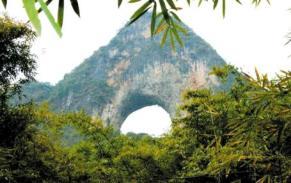
Natural karst "Moon Hill" in Yangshuo
II. A marvellous
creation excelling nature—borrowing the scenery
What's so good about the beauty in nature? It of course cannot be used up and cannot be taken away. The simple truth is, however, no matter how beautiful the scenery is, there is no human consciousness in itself. This has to be given some complements. The essence of the heart-touching landscape art can arouse the natural beauty and drive home to a point otherwise difficult to explain in literary meaning. It all takes an artistic process. In view of the scenery, the first thing to do is to "clarify the heart for appreciation ", to explore the "cause of scenery", and to study the science and aesthetics. The change from "image" to "meaning" should be accomplished by "brainstorming". Creation should be meditative, thinking that it cannot go any deeper, then realize that it's "rather difficult before it's getting easy", and achieve the high level of the "imaginary ".
The reason why the Qingyin Pavilion of Emei Mountain works is that it's being "reasonable and unexpected", as was phrased by the movie artist Mr. Xie Tian (1914.6~2003.12).
Emei Mountain has about a kilometer long rock gully at its side, and in front of the mountain there are two streams rushing down respectively from the west and the north, forming a double-mountain and double-stream scenery resources, natural and nurturant. But what is missing? Culture. Designers then positioned in the center on the level ground the Qingyin Pavilion (Clear Sound Pavilion), which sits in the north and faces the south, extending around the axis southward to the Shuangqiao Qingyin Pavilion (Double Bridge Clear Sound Pavilion) on the mountain.
Change the name of the two streams into Heibai (Black and
White). The one streaming from the west is called Baihu (Constellation of White Tiger); the other from the north Xuanwu
(Constellation of Black Tortoise). The symmetrical stone bridges on the rapid
ups and downs of the mountain stream shape up the main scene of the Double
Bridge Clear Sound. The two streams merge and gully onto a stone, called Niuxin
Stone (Cow's Heart Stone), so that the art piece take it to mean "black
and white water washing cow's heart". It might click the memory log of the
viewer of the old saying "playing the piano to the cow", though it's
supposed to have deaf ears for music may also accept the influence of the clear
sound of mountains and rivers. The environment becomes natural interest,
artificial embellishment pavilion bridge architecture, greatly improved the
simplicity of natural beauty and achieve the amazing effect. Once again it
confirms what Guan Zhong said, "when man and heaven are in tune, then the beauty of world is budding".
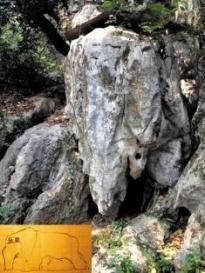
Xiang-Xiang(double elephant)stone in West Lake, Hangzhou
Thus it's meant for the scenic spot and for the scenery
itself, too. By the roadside of the entrance of the Qixia Cave at the West Lake
in Hangzhou, there's a huge limestone, resembling an elephant. And by the same
token, there's a little stone elephant in front of the limestone. The author
engraved the characters 象象(Xiang-Xiang, double elephant), bearing two meanings: they look like elephants and
they're two elephants. An fabulous pun expression for the two Chinese
characters.
III. Conception of Improving the Comprehensive Resources of Huangguoshu Scenic Area
From a disciplinary perspective
1. Take living as an environmental base, and keep continuous reproduction breed in an endless succession. Be mindful of possible danger in times of peace and protect nature, control mountains, rivers and lakes as the basis to protect the lives of residents and visitors. The water control programme should be "safe flow in the track", and "deep beach with low weir". Build debris flow passages and keep residents and visitors far high the passages. Establish debris flow shelter belt. Utilize methods with fine art, and reach methodology through fine art.
2. Be skillful at borrowing, injecting humanity and placing it in the scenery.
The essence of naming the scenery is to "make it knowable to the heart", and turn reality into poetry. First of all, reject the name of the scenery that violates principles of science and art. In addition to the potted landscape gardens, there is a scenic spot by the name of "Tianxing (Star) Bonsai Area", bonsai is a small-scale garden art, its principle is: "Learning from nature outside and deriving from inspiration inside". Scenic spots are natural scenery, and the performance of natural beauty is by no means "true for false, or turning fake into true ". In fact, the scenic spots are all natural mountain waterscape, through rock crevices, good natural landscape, yet when they are named by artificial works, it is belittling nature, blaspheming nature, should be modified. Could it be called "Peeping the Beauty through the Crevice"? because Beauty Banyan is the main scene here. Others are scientific but unkind. If there is a spring can produce a roar called "Roar Spring." There is something wrong with being kind. Could we use the poetic meaning of (Quote: two lines from Bai Juyi in the Tang Dynasty) "Big strings are like cracks in silk, and small strings are like whispers" to call it "Silk-Splitting Springs"? Naming the scene is a major event, we should learn from the masses, and pursue perfection as much as possible.
The
Huangguoshu Scenic Area mainly reflects the characteristics of the zonal plant
Ficus Vasculas. The poetry meanings of traveller Xu Xiake and poets of the past dynasties are
hardly found to concisely incorporate the landscape name. This should deserve a focus study. The Great Fall is
the main part of the scenic area play, should not use a straightforward tour
route. There should be a prelude, a climax, and a final sequence of the
sightseeing emotions. Such a scenic image as "Pool of Silver Chain
Falling" could be a poetic expression for it.
IV. Some thoughts for consultation
The study of the present will have to learn from the past.
• The Huangguoshu Waterfall falls like snowflakes, accompanying the pear tree's red blossoms jumbling down onto me.
-- Guo Zizhang (Ming Dynasty)
• In praise of the Huangguoshu Waterfall, Xu Xiake, the famous traveller of Ming Dynasty wrote, "it falls like foam of tamped beads surging, resembling mist and fog powerfully flying in the sky; and it's like 'the bead curtain getting off its hook and silk cloth marvellously hanging from the remote peak'".
• The flying waterfall hanging on the cliff, with its snowy waves rising for hundreds of fathoms.
Many a time I've been watching you, but I bet I'll never get tired, and I love your clarity and purity that could mirror my heart.
-- Huang Peijie, the executive, Yongning Fu (City), Anshun Prefecture, Qing Dynasty
• The rainbow spring is flying from the above, while the jade rhino is lying underneath.
The waterfall is painting picturesque paintings, unevenly hanging flowing downward,
Spattering like snowflakes in the sun, falling onto the green grass on the shore.
Entering into an alliance with it, and it'll keep your heart clear and quiet.
-- Zhou Mingxian
• Light gauze bead screen hangs half link, misty line rolls purple smoke.
The water and the clouds are churning, and the thunder and the drum are loudly beating.
-- Jiangnan Shimo (Southern Yangtse Poetry Magic)

Author's hand-drawn design plan of Huangguoshu Waterfall Scenic Area
Richly endowed by nature though, does the Huangguoshu Waterfall leave any room for improvement? The answer is yes. The bottleneck is its local adaptability, the simple natural beauty is yet limited to its natural beauty. To break the bottleneck is to "humanize it to achieve a win-win result". As a rule of law, we should have the bedding for the scenic spots. The Chinese literature features "lingering, lingering, and then blurting out the truth", also "do not be so easy and good as pedantic". The grand opera should have its opening as a prelude. The current channel for incoming and outgoing two-way mixed as one. Tourists take the elevator down to 80 meters in a moment, and the long walkway without any scenic spots for rest, will have to take the road back. Another entrance to the mountain should be chose, making use of the mountain stone to build stonearchway, climbing rattan green, reaching the natural stone carved with Confucius saying "Is it a pleasure to have friends coming from afar"? On the archway a couplet were carved: " Endowed by nature; humanized to be interesting". On the front of the archway: "Gorgeous karst wonderland", and on the opposite "Water and stone merrily allied". Change the 80 meters height elevator into the walkway down to the mountain. In the sequence of the waterfall-sighting, waterfall-hearing, and waterfall-watching, three pavilions should be set up along the mountain with wood-stone structure, and banyan column rattan hanging. From "waterfall-sighting pavilions" (望瀑亭Wangputing) to "Waterside pavilion" (闻瀑亭Wenputing), and finally, it reaches "Waterfall-watching Pavilion" (睇瀑亭 Diputing). It transfers you from anxiously-longing-to-see to comfily-pleasing-the-eye.
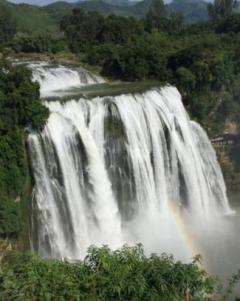
The magnificent Huangguoshu Waterfall, 2015
Photography by Lu Haifeng
The local scenery proper should be the infinite change of natural karst landscape. The main factors are Ficus vasculas, the Great Falls and Rhinoceros Pool. There is now no full expression of what is right and what is wrong. Praises summing up in Xu Xiake's poem are "fabulous and marvellous". The Baishui River has been compared to cotton, and the old local saying goes, "Folks don't take much silver with them." And now in pursuit of sustainability, we can turn clean water and green water into gold and silver mountains, so, shall we name it "Fabulous and Marvellous Milky Way Falling into the Rhinoceros Pool" to reflect the scenic characteristics? The viewpoint is a little far from waterfall, so we can make midview and close-range view in between, and use only the natural factors of scenery.

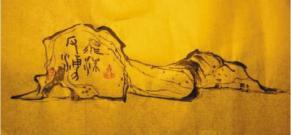
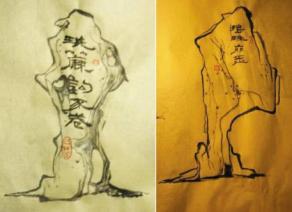
Cliff inscriptions
Finding an empty hole in the cliff wall and plant a big Ficus vasculas tree in it, and it'll naturally form an amazing pattern of roots-mixing walls. And in due time, the roots of the tree will grow deep and the trunks thick. The watery stone and wet air will make the roots luxuriously expand, intertwining and intricating with one another, which will surely match the name of "Alliance of Stone and Banyan". And the banyan trunks will be slanting across the waterfall and vertically appearing to form the "Flying Banyan Exploring the Sea". Laying out silvery white with thick green to let it brim over with life, and then select one of the big rocks in the pool to make the broad back of a lying rhinoceros. Furthermore, choose a natural lake stone which looks closely like the rhino's head and nose and add a new "Rhino Bathing" as the low prospect in the water. Thence the rainbow scene appears again.
Auspicious
beast with auspicious image. Following the conformity of humanity and landscape
context, the connotation, appearance and name of the actual scenery aspects
must be lifted to a higher level.
Meng Zhaozhen, born in Wuhan, Hubei Province, is a famous landscape architecture planning and design educator in China, academician of Chinese Academy of Engineering, and winner of Landscape Architecture Lifetime Achievement Award. He is currently a professor and doctoral tutor of Beijing Forestry University, vice director of landscape architecture expert committee of the Ministry of Construction, head of the landscape architecture advisory group of the Beijing Municipal People's Government, head of the advisory group of the Shanghai Landscaping & City Appearance Administrative Bureau, honorary chairman of the China Landscape Architecture Society, honorary chairman of Beijing Landscape Architecture Society, and visiting researcher of Design & Research Institute of KyungHee University, South Korea.
He graduated from Nankai Middle School of Chongqing in 1952, and majored in gardening from Beijing Agricultural University in September 1956. He was elected academician of Chinese Academy of Engineering in 1999.
Professor Meng Zhaozhen has long been engaged in the teaching and scientific research of garden art, garden design, garden engineering, and Illustrative Interpretation of Yuan Ye.
Copyright © Global Forum on Human Settlements (GFHS)
